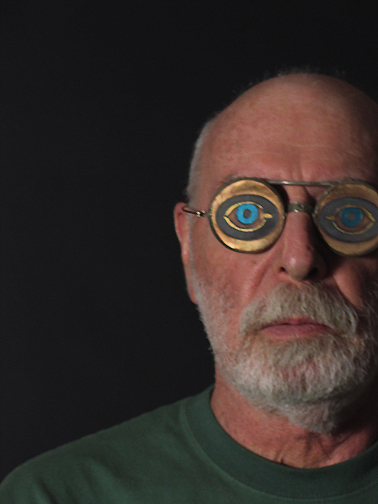Artist Portrait: Zoe Diamant - Big Cake Photography
My working process has led me to incorporate a wide range of techniques into my work including woodcarving, silver soldering, lathe-turning, brazing, welding and gold leafing. The design aspects of my work are largely preconscious and automatistic. I begin work on a new piece or series of pieces only with an initial view and the understanding that the work at hand will lead where it will lead.
Over the past thirty five years I have become more and more interested in vision, particularly in terms of how my pieces may reflect, refract, and distort light. Many of the materials I use—brass, gold, steel, chromium, enamel, wood, various colored glasses, Bakelite, leather—either reflect light naturally or can be finished to do so in a variety of ways. I can then enlarge, reduce, multiply, color, invert, refract or otherwise alter these images by using spherical and strategically curved surfaces, optical lenses and mirrors. In many cases the interplay of light captures and distorts the reflection of the viewer. Many of my recent works incorporate turntables, so the viewer may rotate the work 360 degrees and scrutinize it from an easily available, single point of view.
Many of the sculpted heads that I have finished are constructed in a way that suggests an inseparable relationship between the viewer and the work. In some cases, when one views the heads one might see an image of oneself and/or a reflection of one’s eye in the eye of the sculpture. Of course, as the viewer changes, so changes the image in the sculpture. In addition, due to the spherical shape and mirrored surface of the central element in many of these works, an image of the viewer appears to be situated inside the center of the sculpture, looking out. While the piece rotates, the central images remain constant. Both of these perspectives are unavailable in the “real” world, and are manifested only upon close examination by the viewer.
The interest in the play of light dovetails with my curiosity and affinity for symbols, objects and accessories related to vision. Optometric apparatuses, eye-testing kits, eyeglasses, monocles, goggles and safety glasses, as well as individual corrective lenses—concave, convex, double convex, cross-sighted, bifocal, trifocal, etc.—all appear in my recent work, and serve a double function: as light refractors and symbolic references to clear, deficient, corrected and/or enhanced vision. These references call attention to sight—and insight—in more than just the physical or literal sense. Introspection, self-knowledge, dreaming and glimpses into metaphysical and spiritual realms all fuel my working process, and are indeed manifested in the finished works.
Interestingly, eye related symbology is prevalent in the images and accessories of 19th and 20th century American secret societies (such as Odd Fellows and Masons) that I use in my work. In particular, the left eye is often depicted as the All-Seeing-Eye, the Eye-of-Omniscience and/or the Eye-of-God. The delineation of detail in many of these depictions—found on Society buildings, literature, pendants, pins and other paraphernalia—is extraordinary, and is in fact the primary reason I incorporate such objects into my work. Hoodwinks and blinders were used in initiation rites, further emphasizing the link between sight and knowledge. The position of the Eye and Omniscience as central motifs in these objects is intriguing and alluring, and is rendered more so by the fact that the operations, ideology and knowledge of these societies is unseen by the general public. These societies and other unseen phenomena are a source of constant speculation.
With these references to unseen phenomena, materials from ophthalmology and optometry, and manipulations of light, I hope that my works will affect viewers on multiple levels—visceral, emotional, intellectual—and that one may infer any number of personal meanings. These areas of interest, techniques and materials will most likely in-form my work over the next few years. My decision to concentrate on sculpted heads is motivated by the awareness that they embody both subject and object, and that they engender and circumscribe simultaneously the content of my artistic pursuit. Relieved of these considerations, I merely have to make another—albeit advanced—head and when that is finished, yet another.









